
Pilton is a suburb of the town of Barnstaple, it is located about quarter of a mile north of the town centre, in the civil parish of Barnstaple, in the North Devon district, in the county of Devon, England. It was formerly a separate village. The civil parish of Pilton West covers the more rural parts of the ancient parish of Pilton that have not been incorporated into the town of Barnstaple. In 2009, the Pilton (Barnstaple) ward had a population of 4,239 living in some 1,959 dwellings. It has its own infants and junior school, houses one of Barnstaple's larger secondary schools, and one of Barnstaple's SEN specialist schools. North Devon Hospital is also within West Pilton parish. It has a Church Hall, two public houses, two hotels, and residential homes. It has residential estates of both private and public housing including flats. It also has a historic Church that dates back to at least the 11th Century.
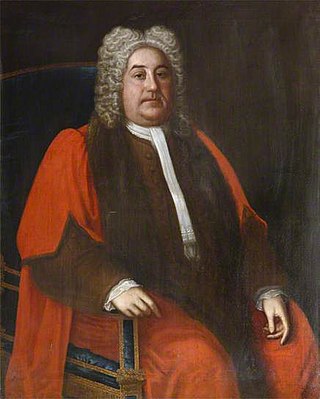
Benjamin Incledon (1730–1796) of Pilton House, Pilton, near Barnstaple in North Devon, was an English antiquarian and genealogist. He served as Recorder of Barnstaple (1758–1796).

The historic manor of Raleigh, near Barnstaple and in the parish of Pilton, North Devon, England, was the first recorded home in the 14th century of the influential Chichester family of Devon. It was recorded in Domesday Book of 1086 together with three other manors that lay within the later-created parish of Pilton. The manor lies above the River Yeo on the southern slope of the hill on top of which stand the ruins of the Anglo-Saxon hillfort called Roborough Castle. Part of the historic manor of Raleigh is now the site of the North Devon District Hospital.

Hall is a large estate within the parish and former manor of Bishop's Tawton, Devon. It was for several centuries the seat of a younger branch of the prominent and ancient North Devon family of Chichester of Raleigh, near Barnstaple. The mansion house is situated about 2 miles south-east of the village of Bishop's Tawton and 4 miles south-east of Barnstaple, and sits on a south facing slope of the valley of the River Taw, overlooking the river towards the village of Atherington. The house and about 2,500 acres of surrounding land continues today to be owned and occupied by descendants, via a female line, of the Chichester family. The present Grade II* listed neo-Jacobean house was built by Robert Chichester between 1844 and 1847 and replaced an earlier building. Near the house to the south at the crossroads of Herner the Chichester family erected in the 1880s a private chapel of ease which contains mediaeval woodwork saved from the demolished Old Guildhall in Barnstaple.
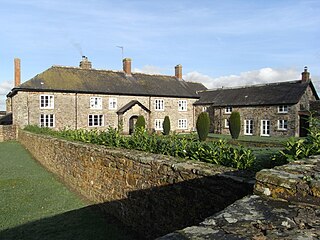
Brightley was historically the principal secondary estate within the parish and former manor of Chittlehampton in the county of Devon, England, situated about 2 1/4 miles south-west of the church and on a hillside above the River Taw. From the early 16th century to 1715 it was the seat of the Giffard family, whose mansion house occupied the moated site immediately to the west of the present large farmhouse known as Brightley Barton, a Grade II listed building which incorporates some elements of the earlier house. It is not to be confused with the 12th-century Brightley Priory near Okehampton.

The landed gentry and nobility of Devonshire, like the rest of the English and European gentry, bore heraldic arms from the start of the age of heraldry circa 1200–1215. The fashion for the display of heraldry ceased about the end of the Victorian era (1901) by which time most of the ancient arms-bearing families of Devonshire had died out, moved away or parted with their landed estates.

John Acland was described as "the first of the [Acland] family to emerge from the shadows of history as a visible human being". His great-grandson was the Royalist colonel Sir John Acland, 1st Baronet of Columb John. Little if anything is known of his life and career, he was possibly a minor Tudor official, but he is chiefly remembered for his surviving portrait which is displayed at Killerton House, the earliest surviving image of an Acland and one of the most cherished in that family's former collection, now owned by the National Trust.

Sir Arthur Acland (1573–1610) of Acland in the parish of Landkey, Devon, was a member of the Devonshire gentry, and was knighted in 1606. Little is known of his life and career, but his monumental inscription survives above his monument in Landkey Church. His son was Sir John Acland, 1st Baronet. He was ancestor to the prominent, wealthy and long-enduring Acland family of Killerton, which survives today in the direct male line.

Hudscott is a historic estate within the parish and former manor of Chittlehampton, Devon. From 1700 it became a seat of a junior branch of the influential Rolle family of Heanton Satchville, Petrockstowe and in 1779 became a secondary seat of the senior Rolle family of Stevenstone, then the largest landowner in Devon. Hudscott House, classified in 1967 a Grade II* listed building, is situated one mile south-east of the village of Chittlehampton. It was largely rebuilt in the 17th century by the Lovering family and in the late 17th century became a refuge for ejected Presbyterial ministers. In 1737 its then occupant Samuel II Rolle (1703-1747) purchased the manor of Chittlehampton and thus Hudscott House became in effect the manor house of Chittlehampton.

The estate of Acland in the parish of Landkey, near Barnstaple in North Devon, England, was from 1155 the earliest known seat of the influential and wealthy family of Acland, to which it gave the surname de Acland. It is situated about 3/4 mile north-east of the village of Landkey, from which it is now cut off by the busy A361 North Devon Link Road.
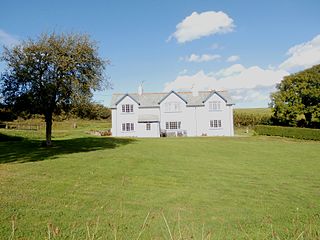
Incledon in the parish of Braunton, North Devon, England, is an ancient historic estate which gave its name to the locally prominent de Incledon family, first recorded in 1160. It is situated one mile north-west of St Brannock's Church in Braunton. Its relationship to Incledon Hill in the parish of Georgeham, where is situated a modern farmhouse also called Incledon, 1 1/4 miles north-west of Incledon in Braunton, is unclear. In 1319 the Incledon family purchased the adjoining estate of Buckland, and the present Georgian Buckland House, 1/2 mile south-east of Incledon, is still occupied in 2014 by descendants of the Incledon-Webber family.

Pilton House in the parish of Pilton, near Barnstaple, North Devon, Ex31, is an historic grade II listed Georgian mansion house built in 1746 by Robert Incledon (1676-1758), twice Mayor of Barnstaple, who was from nearby Braunton. It is situated almost in the centre of the ancient town of Pilton, but had formerly extensive grounds covering at least 20 acres, which extended down "Pilton Lawn", now built over, to the River Yeo. It later served as the residence for various Members of Parliament for Barnstaple, for which it was well suited being only a 10-minute walk from the centre of that town, yet in a secluded situation with extensive grounds, and sufficiently large and grand for entertaining borough officials and electors.

Robert Incledon (1676–1758) of Pilton House, Pilton, near Barnstaple in North Devon, was a lawyer of New Inn, London, a Clerk of the Peace for Devon, Deputy Recorder of Barnstaple and was twice Mayor of Barnstaple, in 1712 and 1721. In 1713 as mayor he supervised the building of the Mercantile Exchange on Barnstaple Quay, as recorded on the building by a contemporary brass plaque and sculpture of his armorials. He built Pilton House in 1746.
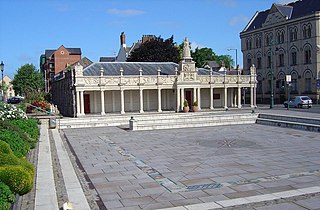
Queen Anne's Walk is a grade I listed building in the town of Barnstaple, North Devon, completed in 1713 as a meeting place for the town's merchants. It is believed to have been designed by the architect William Talman, on the basis of its similarity to his work at the Hall in Drayton, Northamptonshire. It was promoted and financed by the thirteen members of the Corporation of Barnstaple whose armorials are sculpted on and above the parapet, and the work was overseen by Robert Incledon (1676–1758), Mayor of Barnstaple in 1712–13. It has been owned for many decades by North Devon District Council, which currently (2014) leases it to Barnstaple Town Council, and now trades as The Cafe on the Strand.

Yeotown was a historic estate situated in the parish of Goodleigh, North Devon, about 1 1/2 miles north-east of the historic centre of Barnstaple. The mansion house was remodelled in about 1807 in the neo-gothic style by Robert Newton Incledon (1761-1846), eldest son of Benjamin Incledon (1730-1796) of Pilton House, Pilton, near Barnstaple, an antiquarian and genealogist and Recorder of the Borough of Barnstaple (1758–1796). It was demolished during his lifetime and today only one of the large gatehouse survives, since converted into a farmhouse known as Ivy Lodge. The surviving drawing of the house in the collection of the North Devon Athaneum in Barnstaple shows a large chapel, or small church, with a tall square three-storied pinnacled tower attached to the house.

Sir Nicholas II Hooper (1654-1731) of Fullabrook, Braunton and Raleigh, Pilton in Devon, was a lawyer who served as Tory Member of Parliament for Barnstaple 1695-1715.

Mount Radford is an historic estate in the parish of St Leonards, adjacent to the east side of the City of Exeter in Devon.

Hawkridge in the parish of Chittlehampton in North Devon, England, is an historic estate, anciently the seat of a junior branch of the Acland family which originated at nearby Acland, in the parish of Landkey and later achieved great wealth and prominence as the Acland Baronets of Killerton, near Exeter. The former mansion house is today a farmhouse known as Hawkridge Barton, a grade II* listed building. The Devon historian Hoskins (1959) stated of Hawkridge: "Externally there is nothing remarkable except a decaying avenue of ancient walnuts, so often the first indication of a 16th or 17th century mansion". The interior contains a fine plaster heraldic overmantel showing the arms of Acland impaling Tremayne, representing the 1615 marriage of Baldwin Acland (1593–1659) of Hawkridge and Elizabeth Tremayne.
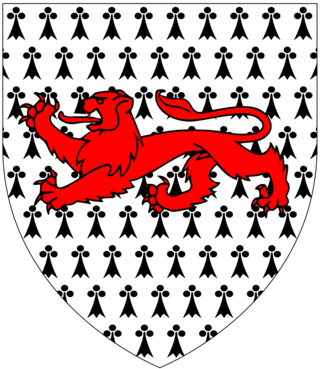
The Drewe family of Broadhembury are generation owners and inhabitants of The Grange, Sharpham, Broadhembury, Wadhurst Park, Devon, in the west and east of England, from the 16th century to the current date.
The lord of the manor of Swimbridge in Devon, England, until the 20th century was the Duke of Bedford, of Woburn Abbey in Bedfordshire and of Endsleigh Cottage in Devon, whose ancestor John Russell, 1st Earl of Bedford (c.1485–1555) of Chenies in Buckinghamshire and of Bedford House in Exeter, Devon, was appointed Lord Lieutenant of Devon by King Henry VIII and obtained large grants of land in that county following the Dissolution of the Monasteries. Thus there is no manor house in Swimbridge as the lord was non-resident. The location of the court house where manorial business was transacted may have been Ernesborough.






















